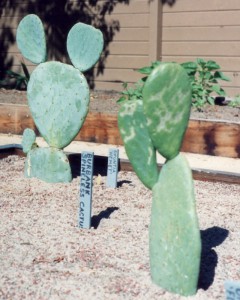
Luther Burbank’s Spineless Cacti: Varieties and Culture
Between 1907 and 1925, Luther Burbank introduced more that 60 varieties of spineless cacti. These were developed mostly from hybrids of varieties of the Indian fig (Opuntia ficus-indica) and the Mexican prickly pear (Opuntia tuna), and were offered in two main types: the fruiting varieties, grown for their variously colored and flavored prickly pears, and the forage varieties, grown for their edible pads (properly called thalli), which could be fed raw to livestock or cooked for human consumption.
How to Grow Spineless Cacti

Plant the pads in an upright position, burying about one-third of the lower end of each pad in sandy, well-drained soil. Firm the soil to hold the pads in place, using short sticks to prop them up, if necessary. Place the pads in a warm, sunny position and protect them from very hot sunlight until they are established. Do not water the pads until they start to develop new green growth, and then limit watering to infrequent deep soakings that allow the soil to dry thoroughly before more water is applied. No fertilizer should be necessary. Plants may be containerized for about a year or so, but should ultimately be given plenty of growing space outdoors in the ground. Young plants may be damaged by severe frosts, although established specimens are quite cold hardy.
Uses for Spineless Cacti
Mostly adapted from suggestions by Luther Burbank, circa 1914
Plants – can be grown as hedges and fences
Woody skeletons – can be used in construction of houses, rustic furniture, and to make trinkets such as fans, etc.
Stems – have sap that can be extracted to make chewing gum
Thalli (“pads” or leaves”)
- can be used for fodder (and drink) for livestock and poultry
- can substitute for a hot water bottle
- can be split open and used as poultices to relieve inflammation; when soaked in water they release viscous juice that promotes healing of wounds and bruises
Juice from thalli
- can be used to manufacture candles
- can be spread on water, like petroleum, to smother mosquito larvae (lasts up to a year, according to tests in central Africa, reported in Scientific American, 1911)
- can be boiled down to use as mucilage, or to mix with whitewash (increases durability) or mortar (increases stickiness)
Young shoots ( “nopales” or “nopalitos”)
- can be boiled and fried like eggplant
- are mucilaginous, like okra, and when boiled with garlic and onions, can be chopped and cooked with shellfish, pork, and eggs; can be flavored with chopped tomatoes, chilies, or coriander
- can be pickled with spices
- can be pulped and dried for future use
Fruit (“tunas” or “prickly pear”)
- can be eaten raw or chilled and served with lemon juice
- can be cooked into jams, and preserves like apple butter
- can be cooked down into dark red or black paste called “mile coacha” and fermented into a drink called “coloncha”
- can be dried for future use, or made into flour that is baked into small sweet cakes called “queso de tuna”
- can be dried and made into candy
Fruit juice
- can be used as food coloring
- can be used as a natural dye for yarn
Seed
- can be eaten in soups
- can be dried and ground into flour
